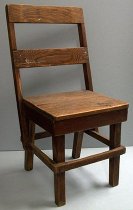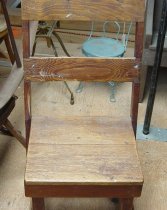Object Record
Images



Metadata
Title |
Chair made by Kanichi Eguchi at Rohwer, Arkansas Relocation Center, c. 1942-1945 |
Object Name |
Chair |
Description |
Chair made by Kanichi Eguchi at Rohwer, Arkansas Relocation Center, c. 1942-1945. Wooden chair (shaped like an h) made in Rohwer, Arkansas Relocation Center by donor's father-in-law. It has a slightly tilted wooden seat back, four wooden legs, a seat connected to the top of four wooden legs, and the stretcher, which is the horizontal support elements joining the the four wooden legs . The slightly tilted seat back are 2 by 2 small thin wooden boards which connected to its two small boards, each at 4.5" by height and 17.5" by width. The 2 by 2 small thin wooden boards are also have metal screws on the left and right sides of the boards that connect to the left and right side of the seat, and the part of the square thin boards that are connected and around the middle portion of the four wooden legs. Those two small boards are connected to either three or four metal nails on each side on the front of each board connecting them to the rest of the seat back. The top of the seat has two pieces of wood separate, but next to each other making the appearance of a seat. On the top of these two boards, there are small three or four thin metal nails on each side connecting the boards on top of the rest of the seat. On the side of the square seat, there are three bigger metal nails on the left, right, front and back end of the square seat. Underneath the square seat, the wood appears to be unfinished and where the wooden legs connect to the seat. The wooden legs are similar to the slightly tilted seat back, and are connected by two small metal nails in the back of the chair. They are also two bigger metal nails around the the stretcher that connects the four wooden legs. Parts of the seat back, the wooden legs, and the seat are made of wooden varnish that making have a more polished look. The top front of the seat and the square thin boards have an unpolished look, with some matting. |
Date |
c. 1942-1945 |
Creator |
Eguchi, Kanichi |
Role |
Wood-carver |
Catalog Number |
2005.024.001 |
Dimensions |
H-34 W-15 D-2.5 inches |
Collection |
3D - Furniture |
Inscription Text |
none |
Provenance |
Japanese Internment |
Notes |
"Kanichi Eguchi was born in 1888 in Japan either Kiushiu or Kyushu Island. He and his family lived in San Mateo, California. He was one of 103,014 for Japanese Americans evacuated from the states of Washington, Oregon and California to ten relocation centers operated by the war Relocation Authority during World War II. He was sent to He spoke, wrote and read Japanese, and spoke English. He and his wife Mito were both sent to Rohwer Assembly Center in Stockton, California. Both his birth mother and father were from Japan with his father's occupation as a farm operator or manager. He only went to elementary school for 8 years and has no degree. He arrived in the United States in 1912, spent 20 or more years in Japan. He died in 1973." [http://www.japaneserelocation.org/index.php?page=directory&rec=6423-10/18/2016] "The euphemistically named "Rohwer Relocation Center" in Arkansas was one of ten concentration camps administered by the War Relocation Authority (WRA) to house Japanese Americans forcibly removed from the West Coast during World War II...The Rohwer site is located in southeastern Arkansas, in Desha County, twelve miles northeast of McGehee, 110 miles southeast of Little Rock, and just 27 miles from the Rohwer camp....The Rohwer site is located in southeastern Arkansas, in Desha County, twelve miles northeast of McGehee, 110 miles southeast of Little Rock, and just 27 miles from the Rohwer camp." [http://encyclopedia.densho.org/Rohwer/-10/18/2016] "The Stockton Assembly Center was one of fifteen temporary detention centers (euphemistically called "assembly centers") administered by the Wartime Civil Control Administration. Most Japanese Americans forcibly removed from the West Coast were sent to one of these centers during the spring and summer of 1942 while the more permanent concentration camps were being prepared...The Stockton Assembly Center was built at the San Joaquin County Fairgrounds site, just a few blocks southeast of the Stockton city center. The detention facility was populated from May 10 to October 17, a total of 160 days. The site included 125 barracks in the racetrack infield, along with forty more east of the fairgrounds...Upon the closing of the camp, nearly all of the inmates were transferred to the Rohwer, Arkansas camp for long-term confinement, with a handful being sent to Gila River, Arizona." [http://encyclopedia.densho.org/Stockton_%28detention_facility%29/-10/18/2016] |
Search Terms |
Chair Chairs Furniture Household Goods Japanese - World War II Japanese Americans Japanese Americans - Internment Japanese Americans - Relocation Center WWII |
Subjects |
Chairs Furniture Japanese internment World War II |
People |
Eguchi, Kanichi |
Credit line |
Courtesy of Yoneo Kawakita |
